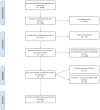The Cytotoxic and Inhibitory Effects of Plant Derivatives on Candida albicans Biofilms: A Scoping Review
- PMID: 36615324
- PMCID: PMC9822484
- DOI: 10.3390/molecules28010130
The Cytotoxic and Inhibitory Effects of Plant Derivatives on Candida albicans Biofilms: A Scoping Review
Abstract
Candida albicans infections are related to biofilm formation. The increase in antifungal resistance and their adverse effects have led to the search for therapeutic options as plant derivatives. This scoping review aims to identify the current status of in vitro research on the cytotoxicity and inhibitory effects of plant derivatives on C. albicans biofilms. In this study, PRISMA items were followed. After recognition of the inclusion criteria, full texts were read and disagreements were resolved with a third party. A risk of bias assessment was performed, and information was summarized using Microsoft Office Excel. Thirty-nine papers fulfilling the selection criteria were included. The risk of bias analysis identified most of the studies as low risk. Studies evaluated plant derivatives such as extracts, essential oils, terpenes, alkaloids, flavonoids and polyphenols. Some studies evaluated the inhibition of C. albicans biofilm formation, inhibition on preformed biofilms or both. The derivatives at concentrations greater than or equal to those that have an inhibitory effect on C. albicans biofilms, without showing cytotoxicity, include magnoflorin, ellagic acid, myricetin and eucarobustol from Eucalyptus robusta and, as the works in which these derivatives were studied are of good quality, it is desirable to carry out study in other experimental phases, with methodologies that generate comparable information.
Keywords: Candida albicans; biofilms; plant extracts; toxicity.
Conflict of interest statement
The authors declare no conflict of interest.
Figures
References
Publication types
MeSH terms
Substances
LinkOut - more resources
Full Text Sources
Medical


